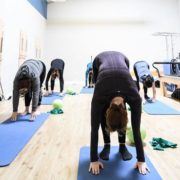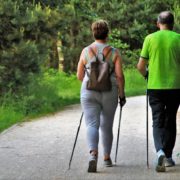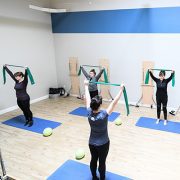Neck Pain Not Going Away? 3 Reasons Why
Over 30% of people report they have neck pain, and of those, 50% will continue to have problems without any real answers or solutions. The last 2 years of the pandemic saw people becoming generally less active, falling off their routines, and working from home in less than optimal “work stations”. It’s no surprise that people are suffering from more neck pain than usual.
Having been a mechanical spine pain specialist for the last 10 years – and a physical therapist for just over 20 – I can tell you that resolving neck pain is trickier than resolving back pain.
And there are some good reasons for that. Your neck is the most mobile area of your spine – which makes it more complicated to manage – and the muscles in your neck are a bit more fragile than some of the bigger muscles in your lower back. The way you strengthen muscles in your neck can’t be approached in the same manner you might tackle your lower back – for example.
While there are several reasons for your neck pain not going away – the biggest culprit I have found is inaccurate diagnosis. Without an accurate diagnosis – your neck pain treatment fails – and it’s more likely you’ll be prescribed injections or pills to relieve your neck pain and get stuck with this treatment regimen for the long-term.
Here are three reasons why the root cause of your neck pain might be getting missed – and why your neck pain just isn’t going away:
1. Your neck problem is disguised as shoulder pain:
Shoulder problems are confused with neck problems more often than you would think. If this happens – you risk spending weeks (or months) trying to resolve shoulder pain that is actually a neck problem. Not only will your shoulder pain not fully resolve – your neck pain won’t either – and could actually become worse. Because your neck is so mobile, it’s easy for nerves in your neck to get irritated and refer pain into the middle of your shoulder blade, top of your shoulder, or down the side of your arm. When you consider this, it makes sense why neck problems are so easily mis-diagnosed as shoulder problems. It’s a very common scenario that not only results in neck pain not going away – but persistent shoulder problems too. My general rule of thumb – if you’ve been working on a particular problem persistently and consistently for 2-3 weeks or more without significant improvement – something is missing. You’re either treating the wrong thing or have the wrong treatment approach. It happens a lot with neck pain so be sure to pay attention to this common error – especially if you’ve got coinciding shoulder pain.
2. Your core is weak:
Lack of core strength is commonly associated with back problems – but believe it or not – it can have a lot to do with neck pain too. Most people are familiar with how muscles and joints are connected – but did you know your muscles and organs are connected as well? They’re connected by a web of tissue called fascia – and this connection is often referred to as myofascial. “Myofascially speaking” – your deep neck muscles are connected to your core. If your core isn’t functioning properly – your neck will try to compensate and it will result in neck pain. Do you consistently feel neck pain or tightness every time you do a core workout? This could be a sign that your neck is compensating for your core – and there’s a good chance proper core strengthening is what’s missing. It could explain why your neck pain isn’t going away no matter how aggressively you treat it.
3. Not working with an expert:
The anatomy of your neck, more so than the rest of your spine, is fairly intricate and quite mobile. Not only does this require special care and accuracy when it comes to examining your neck, it makes it easy for someone who is not expertly trained to miss things. For example, one of the most common things I see is someone thinking that full range of motion has been restored in your neck when it hasn’t. If you start strengthening your neck when it doesn’t have full mobility, you can run into problems later on that result in persistent pain. Additionally, strengthening the muscles in your neck, especially in a neck that hurts, needs to be done carefully. The muscles in your neck were designed for stability – which is very different from say – the muscles in your legs – which are designed for power. You can’t approach strengthening them in the same way. All too often I see neck strengthening exercises that are too aggressive for the small muscles in your neck. This results in unnecessary neck tension – and delayed resolution of neck pain.
Generally speaking – if you’ve been suffering from neck pain for a while now – and despite trying lots of different treatments you’re still having problems – there’s a really good chance you’ve got the wrong treatment approach because you’ve been misdiagnosed. Don’t settle for relying on pills or injections for the rest of your life. And don’t undergo any kind of surgery or procedure until you’ve truly exhausted all possible causes of your neck pain. Ideally, find a neck pain expert and work with them, particularly one who prioritizes natural, movement-based solutions over pills and procedures. If diagnosed properly, it’s not only possible to get rid of your neck pain naturally, but learn to keep it gone all on your own.
Ready to get rid of your neck pain?
Check out this totally free guide on 7 Easy Ways to Get rid of Neck & Shoulder Pain to learn easy tips that are PROVEN to help your neck and shoulder pain – without pills, procedure, or surgery. CLICK HERE to get the free guide.
Dr. Carrie Jose, Physical Therapist and Pilates expert, owns CJ Physical Therapy & Pilates in Portsmouth, NH. To get a free copy of her guide to taking care of back pain – click here.











